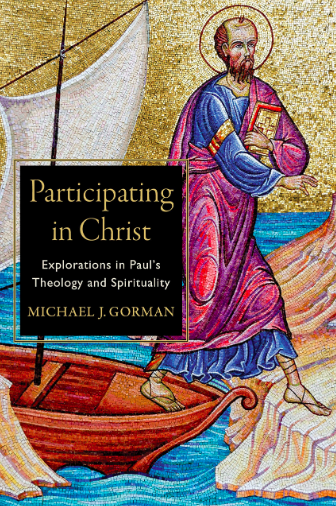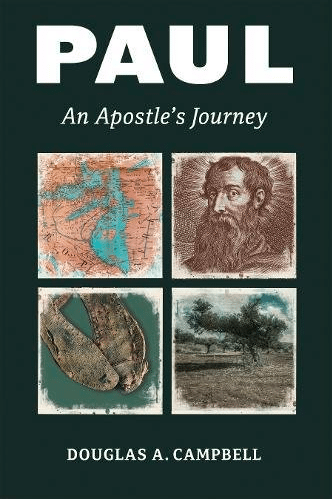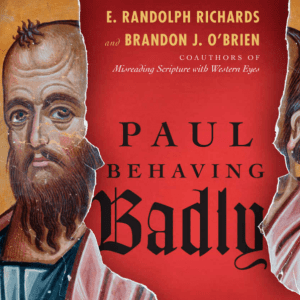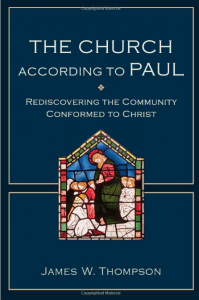 The cover of N.T. Wright’s new Paul and His Recent Interpreters, in the English edition (sadly not the USA edition), goes to the heart of the book. Some might not notice that the cover of the book is Rembrandt’s self portrait as the apostle Paul. (Image credit)
The cover of N.T. Wright’s new Paul and His Recent Interpreters, in the English edition (sadly not the USA edition), goes to the heart of the book. Some might not notice that the cover of the book is Rembrandt’s self portrait as the apostle Paul. (Image credit)
Rembrandt painting himself as the apostle Paul, think of it. Then take notice: all interpretations of the apostle Paul are in part self-portraits. Tom is not cynical or even deeply ironical; he’s honest and knows whereof he speaks. Most major Pauline interpreters are self-aware enough to know their own theology gets a lift in their interpretations of Paul — “old” perspective readers find a John Calvin or a Martin Luther kind of Paul, “new” perspective readers find a sensitive-to-Judaism Paul, apocalyptic perspective readers find a cosmic justice Paul very much in attuned to their political orientations. I could go on… what we need not do is say anymore about the unfortunate choice in the USA not to have that Rembrandt on the cover. That cover makes for an informed and telling conversation.
All interpretations of Paul, Wright contends, involve four tasks: history, theology, exegesis and application (or implication for our world). In an early description Wright looks at F.C. Baur (1792-1860), a giant interpreter who shifted for all time the interpretation of Paul by posing Paul between two movements, by posing Paul in a Hegelian dialectic: Jewish Christianity, Paul, early Catholicism. In this model — let the reader understand the deep, social and eventually military implications — Paul made a clean break from the nationalistic and ethnic-bound faith of earliest Jewish Christianity and opened the door to a universal God with a universal people with a universal ethic. (And some wonder why folks like me complain about turning kingdom into universal redemption instead of seeing it as it was in Jesus’ world — a Jewish people being expanded, not a Jewish people be superseded by the church. The same issue arises for kingdom as it does for Paul’s theology through Baur’s and German scholarship’s conscious and long-term battle with de-Judaizing Christianity.) Wright’s summary:
This enabled Baur to make another Hegelian move. The ‘spirit’ at work within the dialectical historical process made its way by ‘thesis’, followed by ‘antithesis’, and then ‘synthesis’: thus, for Baur, the ‘thesis’ of Petrine (i.e. Jewish) Christianity and the ‘antithesis’ of Pauline (i.e. gentile) Christianity were destined eventually to reach a ‘synthesis’ in the ‘early Catholicism’ of the second century. This, Baur thought, could already be seen in Acts and the Pastoral Epistles (13-14).
This might seem ironic, in that Baur was supposedly himself an historian. But his ‘history’ was, relentlessly, the projection onto the ancient world of the Idealist scheme we have just described. Documents were dated early or late, ascribed to this author or denied to that one, on the basis of this grand scheme (14).
This was the picture that dominated German scholarship in the late nineteenth and early twentieth centuries: (a) a focus on ‘religion’ as the primary category; (b) a sharp distinction between ‘Judaism’ and ‘Hellenism’, with Paul as the pioneer of ‘gentile Christianity; (c) the centrality to Paul of ‘justification’, in Baur’s sense of a new spiritual experience. Sanders, Martyn and Meeks do not often refer to Baur, but his picture is the one they are ultimately rejecting (15-16). [Question to self: Is the old perspective therefore necessarily indebted to Baur’s depiction? Not directly of course.]
The drive away from Judaism led to the drive to find the origin of Paul’s ideas in the Gentile world — enter now Bultmann, whose work rarely anchors Paul in the Old Testament or Judaism. Hence, too, then the colossal importance of Albert Schweitzer, who sought to locate Paul in apocalyptic Judaism but whose views were largely ignored among Germans, and then especially W.D. Davies (Paul and Rabbinic Judaism), who sought to show that Paul was not derived from the Gentile world but from Judaism, and in particular rabbinic Judaism. That rabbinic context is now disputed since the rabbis are later, but no one can dispute that G.F. Moore and then W.D. Davies (and then his student EP Sanders) drove Pauline scholarship away from Bultmann and his disciples (e.g., Bornkamm; in the USA in H. Koester) and their Gentile context for Paul toward a Jewish orientation toward Paul. (Which is where we are today.)
A personal note. I remember this as part of my own academic life: Bultmann’s ilk declined quickly when Sanders blew smoke in that tradition’s eyes. Bultmann became immediately irrelevant to many; Sanders and the Dead Sea Scrolls and the Jewish Pseudepigrapha suddenly became the game we played — along with constant examination of how the NT uses the OT and how that forms the bedrock of NT theology.
Wright backs up to theological questions and his big idea in chp 2 is that the soteriological questions of the 14-15th centuries, answered as they were by the Reformers (Luther, Calvin – Wright sides with Calvin and always has), were both not Paul’s questions or Paul’s answers but were instead questions of their day answered by appealing to important themes in Paul. But those themes are not necessarily how Paul framed his answers to very different 1st Century questions. (Which were not “How can I then be saved?”)
Rembrandt above reminder.
Now to Wright again: “But gradually, bit by bit, starting with Schweitzer and coming forward with the speed but also the relentlessness of a glacier, scholarship has been working towards the problem: what questions was Paul asking* What were the burning issues in his world, in his day? How was ‘salvation’ itself conceived within that world?” (32).
 Schweitzer, then, saw Paul in Jewish terms — in what he called “Christ mysticism,” or union with Christ. When Sanders wrote in 1977 he proposed a variant and improvement on Schweitzer’s mysticism, calling it “participation in Christ” or eschatological participation. Schweitzer famously saw the dominant idea in Paul to be mysticism and justification was a crater inside mysticism, but justification was not the center of Paul’s theology. Both Schweitzer and Sanders, however, make Paul into a soteriologian, something Wright has contended against for a long, long time.
Schweitzer, then, saw Paul in Jewish terms — in what he called “Christ mysticism,” or union with Christ. When Sanders wrote in 1977 he proposed a variant and improvement on Schweitzer’s mysticism, calling it “participation in Christ” or eschatological participation. Schweitzer famously saw the dominant idea in Paul to be mysticism and justification was a crater inside mysticism, but justification was not the center of Paul’s theology. Both Schweitzer and Sanders, however, make Paul into a soteriologian, something Wright has contended against for a long, long time.
Oscar Cullmann’s salvation history concerned folks like Barth (and Cullmann posed his ideas against folks like Barth): he saw the Bible as a redemptive historical process while the Barth types wanted no part of a Hegelian immanent approach to history as redemption since it gave ground to the German Christian (Third Reich church). Note: Cullmann was hugely influential on GE Ladd’s salvation historical approach to NT theology. For all of Cullmann’s salv-hist approach, the historical largely ignores the OT template and Judaism’s own templates of how to understand that history. In the end, Cullmann becomes a defense of a kind of supersessionism. But Cullmann knew that the Bultmann school was de-Judaizing the Bible and he sought to remedy it by creating a Jewish salvation history. The game is on: who is the least complicit in the Holocaust?!
Notice Rembrandt’s Aristotle looking at Homer, with Aristotle dressed up like Rembrandt confusing who the “objective” viewer of Homer really is. [Image credit]
Ernst Käsemann, imprisoned by the National Socialists for his Confessing Church commitments, rises into this to stand with Barth and against Cullmann and (in the USA at the time) Krister Stendahl. Käsemann’s contention is that redemption does not come through a historical approach but through an apocalyptic approach. History leads to WW 1 and WW 2; apocalyptic throws it all onto God and away from what we accomplish. Here, not Schweitzer, are the seeds of the apocalyptic Paul. But for Käsemann “apocalyptic” always means “imminent expectation” (a la Schweitzer). And apocalyptic disengages Paul from Judaism’s apocalypses and the NT apocalyptic material and God’s righteousness was God’s saving power and is less covenantal and more cosmic. Wright wonders if Käsemann has not demythologized apocalyptic and made it more like what he was fighting: Gnosticism. Apocalyptic then — go back to Baur — is the way to disagree with Judaism and against later enthusiasms and early Christianity. [Note to readers: anyone who thinks the Apocalyptic Paul perspective escapes supersessionism becomes preposterous by any reading of Käsemann; read Wright’s summaries here, not least p. 55 n. 92.]
Wright has a beautiful section on CEB Cranfield, who saw too much Marcionism in the Lutheran reading of Paul. Also a good section HR Ridderbos, who was a salvation-historical thinker. (I read Ridderbos between college and seminary along with Ladd and the two made me a salvation historical thinker.) Ridderbos, as is the case with many of his era, did not sufficiently integrate Israel’s narrative into their theology of Paul.











